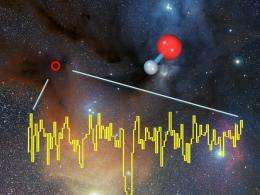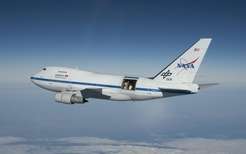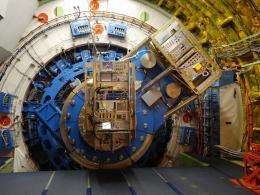OD and SH - two new molecules in space

(Phys.org) -- The discovery of two new molecules and a detailed analysis of various phases of star formation – this is what the observatory SOFIA can report after completing its first series of science flights. The scientific results are now being published in a special issue of the European Journal Astronomy & Astrophysics. The GREAT instrument has been developed by a consortium of German research institutes led by Rolf Güsten from the Max Planck Institute for Radio Astronomy.
The first series of astronomical observations with the German Receiver for Astronomy at Terahertz Frequencies (GREAT) on board the Stratospheric Observatory for Infrared Astronomy (SOFIA) has been successfully completed in November last year. Now, six months later, the scientific results are published in a special issue of the prestigious European Journal Astronomy & Astrophysics. In a total of 22 articles an international group of scientists reports on unique first astronomical results as well as the technologies used.

A joint project between NASA and the German Aerospace Center (Deutsches Zentrum für Luft- und Raumfahrt, DLR), SOFIA operates a 2.7-m telescope in a modified Boeing 747SP aircraft and is the world's only operational airborne observatory. SOFIA flies at altitudes as high as 13700 meters to provide access to astronomical signals at far-infrared wavelengths that would otherwise be blocked due to absorption by water vapor in the atmosphere. The SOFIA observatory opens the far-infrared skies for high-resolution spectroscopy with GREAT, while GREAT pushes its technology to higher frequencies and sensitivities than ever reached before.
“The high resolving power of the GREAT spectrometer is designed for studies of the interstellar gas and the stellar life cycle, from a protostar’s early embryonic phase when still embedded in its parental cloud, to an evolved star’s death when the stellar envelope is ejected back into space”, says Rolf Güsten from the Max Planck Institute for Radio Astronomy (the Principal Investigator of the GREAT project. “This stunning collection of first science results is the reward for the many years of development work, and underlines the scientific potential of airborne far-infrared spectroscopy.”

Many of the contributed papers study the star formation process in its earliest phases, when the embryonic star is vigorously interacting with its surrounding parental molecular clouds –tearing them apart and ionizing them. The high spectral resolution capabilities of GREAT allowed resolving the velocity field of the gas in the parental molecular clouds traced by the important cooling line radiation of ionized carbon in several star forming regions. GREAT detected the velocity signature of collapse in the envelopes of three protostars, directly probing the dynamics of a forming star. Two interstellar molecular species were detected for the first time ever: OD, an isotopic substitute of hydroxyl (OH) with the hydrogen atom replaced by the heavier deuterium, and the mercapto radical SH. Pushing to technological frontiers, observations of the ground-state transition of OH at 2.5 Terahertz (120 µm wavelength) explore new astrophysical territories. The remnant envelope of an evolved star, ionized by its hot stellar core, was investigated and the violent shock interaction of a supernova remnant with the surrounding interstellar medium. The nature of the accretion disk, ultimately feeding the black hole in the centre of the Milky Way galaxy was studied, and also star formation in the nucleus of the nearby galaxy IC342.
“The rich harvest of scientific results from this first observing campaign with SOFIA and the GREAT instrument only gives a first glimpse of the tremendous scientific potential of this observatory” states Jürgen Stutzki from Cologne University, co-investigator of the GREAT project. SOFIA will take advantage of rapid instrumental innovations, allowing instruments like GREAT to be continuously adapted to the newest technologies, and thus promises exciting astronomical observations for the coming years.
More information: Science from observations with GREAT during the Early Science phase, Astronomy & Astrophysics, Volume 542, 10 May 2012
Provided by Max Planck Society



















